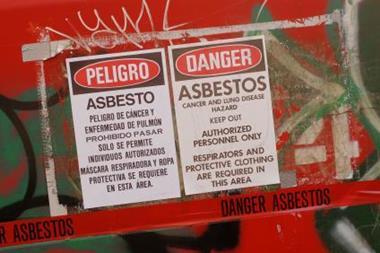Two reinsurance titans; one seriously demanding economic environment. We talk to the men in control, steering their operations towards growth, and mindful of the challenges ahead
Munich Re: steady as she grows
Torsten Jeworrek, head of Munich Re’s reinsurance division, is clearly not a gambling man. While he plays for high stakes – offering large lines of capacity to clients is one of the cornerstones of Munich Re’s unique sales proposition – he doesn’t want his underwriters to leave anything to chance.
“I might see a €1m treaty that produced a €50m loss but congratulate the underwriter on a job well done,” Jeworrek says. “Yet I might see a similar treaty with no losses, and accuse the underwriter of doing a lousy job because it was written on unprofitable assumptions, despite the fact we were lucky this year and had no loss.”
He adds: “A large loss is not a problem per se: losses are part of our business. But, irrespective of the loss, the question is whether the treaty was written on reasonable assumptions that would have allowed profitability under normal conditions.”
Jeworrek argues that if Munich Re’s underwriters were penalised for large losses despite underwriting the risk correctly, they might be deterred from offering clients large amounts of capacity.
Measured approach
Munich Re takes underwriting profitability very seriously, and has a raft of systems in place to ensure that nothing in what Jeworrek describes as the “complex animal” of its global reinsurance operation goes awry. At the heart of this is the value-based management (VBM) metric, which the company uses for all its profit centres.
As part of this, Munich Re insists that all its divisions earn a 15% return on risk-adjusted capital (RORAC) after tax on the capital they are allocated by the group. A profit centre can receive more capital than it is initially allocated for growth purposes, but if it does not feel that it can earn a 15% RORAC, it must return it to the group.
A further component of Munich Re’s underwriting profitability drive is employee selection. Jeworrek says the company pays especially close attention to the personal characters of its managers. “This may sound strange, but we have learned over time that profit centre heads who are greedy and want to pursue short-term success are not the best managers for our business,” he says.
He argues that it would be easy, for example, to add an additional €2bn (£1.7bn) of top line at the next renewals, but the price and terms would be so poor that reserve strengthening would be required several years down the line. “Production is not an art in our business and can be done by anyone. The combination of profitable growth and measuring the profitability in the right way is the art.”
Maintaining underwriting profitability through the cycle is only one of Munich Re’s priorities, however. The second is enacting its strategy of offering what Jeworrek describes as a premium reinsurance product. “We believe our competitive advantages are extremely good financial strength, high rating and large capacity combined with the best risk knowledge,” he says.
Munich Re’s strategy has three main parts. The first is serving its traditional client base – insurance companies – with everything from standard products through to risk modelling and capital management advice.
The second is attempting to make large and complex risks more manageable for clients, for example by offering modelling capabilities, in the hope that this will in turn generate more reinsurance business.
The third element of the strategy involves offering primary insurance for specialty industrial risks, large projects and public-private partnerships. The Munich Re group has a primary insurance arm, ERGO, but these products are offered by the reinsurance group under the auspices of Munich Re Risk Solutions. It could be assumed that Munich Re’s core client base would baulk at competing in the same market as them, but Jeworrek insists that his division’s foray into the primary market has been carefully managed to avoid upsetting customers.
“We have Chinese walls in place and, for our large industrial risks business, even a separate board member – Thomas Blunck – who oversees that business,” he says. “Also, clients have learned that we are a responsible player and don’t aggressively compete for volume. I think Munich Re Risk Solutions has been well received in the market but of course our clients’ concerns are always taken into consideration.”
Going for growth
While Munich Re is in all major markets and lines of reinsurance business, Jeworrek still believes there is opportunity for expansion. For one, he believes the European Commission’s new Solvency II capital regime, due to come into force in January 2013, will encourage insurance companies to buy more reinsurance, particularly from highly rated reinsurers.
“Solvency II is going to change the insurance industry substantially,” he says. “Small- and medium-sized insurers without a substantial financial cushion and whose portfolio is not highly diversified will profit much more from reinsurance solutions.”
Jeworrek also sees opportunities in insuring risks arising from the use of new technologies. “There is a huge demand for risk transfer solutions coming from new technologies or changes in the supply chain, for which our industry has not found adequate products yet,” he says. “If we do that in a responsible way, I believe we can develop new types of business.”
Jeworrek is keen to expand into insuring renewable energy sources. “Renewable energy is at an early stage and will develop substantially in the coming decades. I believe now is the right time to develop appropriate insurance products and build partnerships with technology companies to understand their products.”
Munich Re is the co-founder of Dii, a private joint venture aimed at accelerating the implementation of the DESERTEC Concept – which aims to establish fields of solar panels in deserts to generate sustainable power – in Europe, the Middle East and North Africa. “New insurance products like performance guarantee covers reduce the investment risk for private investments in these new technologies, which helps to attract private investors,” he says. “Munich Re has the necessary expertise on board to develop such products. This is one of the motivations for our role in Dii.”
Jeworrek’s strategy seems to be paying off. Despite a first half marred by heavy natural catastrophe losses, Munich Re’s reinsurance segment made a consolidated profit of €1.05bn, down from €1.31bn in the first half of 2009. The reinsurance property/casualty ratio for the first half increased to an unprofitable 106.4% from a profitable 97.9%, but excluding the 12.8 percentage points added by natural catastrophes, the 2010 figure would have been 93.6%. Just don’t put it down to luck.
Swiss Re: reversal of fortune
Starting a new job is always challenging, but prize for the worst first week in post should surely go to Swiss Re chief executive Stefan Lippe.
He was named successor to previous chief Jacques Aigrain, a former investment banker, on 12 February following the revelation of a 2008 loss of CHF864m (£548m) on the back of CHF9.5bn of realised investment losses. Lippe recalls presenting the finalised set of results on 19 February to an audience clamouring for answers about the company’s new strategy. He promised to return in 100 days with answers.
By many measures, Lippe inherited a mess. Unrealised investment losses arising from a portfolio of credit default swaps (CDS) and portfolio credit default swaps (PCDS) held by Swiss Re’s asset management division helped to wipe CHF11.4bn off Swiss Re’s shareholders’ equity.
The capital reduction prompted rating agency Standard & Poor’s to cut Swiss Re’s rating to A+ from AA-. This was despite a CHF3bn capital injection from Berkshire Hathaway via a convertible instrument, which was announced on the day the losses were first revealed.
This action called into question both Swiss Re’s solvency capital adequacy and the strength of its client franchise; many cedants are only comfortable placing certain risks with reinsurers rated in the double-A range. It also raised concerns about whether the company was still over-exposed to risks on the asset side of its balance sheet.
Fortunately, the underwriting part of its business was sound. The property/casualty combined ratio for 2008 was 97.9%. Also Lippe, with his strong reinsurance underwriting background, was arguably best placed to shift the focus away from taking asset risk.
Lippe’ll fix it
Lippe immediately set about tackling Swiss Re’s problems. This included hiving off the troublesome CDS and PCDS instruments, plus the company’s financial guarantee reinsurance business into a separate section labelled ‘legacy’ and withdrawing from them. It also meant making the reinsurer’s asset mix more conservative.
“There was never a doubt that this company was good at underwriting and managing the cycle. But we strayed from our core reinsurance strategy,” Lippe says. “We still do asset management – insurers and reinsurers need to perform asset-liability management – but we will not compete with investment banks and other professionals in the banking world.”
A heartening find for Lippe was that, despite the downgrade, Swiss Re’s clients had not taken flight. Far from it. “Even I had underestimated the strength of our client franchise,” he says. “No major client said they would stop doing business with us because of counterparty risk concerns, and some even called us asking whether they could help with capital.”
Fortune favours the brave
By the second half of 2010, Swiss Re was back on track. The firm made a first-half 2010 profit of $970m, compared with a loss of $212m in the same period last year. The company’s capitalisation at 30 June was $10bn more than is required for a double-A S&P rating.
One of the keys to the successful turnaround, says Lippe, was resisting the temptation to ditch the toxic assets at the earliest opportunity – and the lowest price. “We didn’t panic, even though the rest of the market was. We had offers to sell off our legacy portfolio at a significant discount, but we made a $100m profit.”
Lippe admits, however, that fortune was on his side in that the market conditions improved in the second and third quarters of 2009, allowing
for a more profitable sale of the unwanted assets.The result is that the notional exposures in the legacy book are now greatly reduced. The company no longer has any exposure to CDS, while the PCDS exposures have fallen to $300m from $13bn at the end of 2009. The company still has $3.9bn of its $14.7bn in exposures from the financial guarantee reinsurance business, but Lippe says the majority of this is government-protected.
In addition to addressing the asset side of the balance sheet, Lippe has also been repositioning Swiss Re’s property/casualty reinsurance book. “We axed $1.2bn of top line in the first quarter and I have more or less personally thrown out around $500m on the credit side,” he says. “If you want to improve your bottom line, you have to have the guts to do what you think is right, despite the opinion in the street.”
There is still work to be done, however. For one, Lippe is keen to get Swiss Re’s double-A rating from S&P back. “Only S&P can decide whether we get it. The only thing we can do is show them that we have profitable business and significant excess capital, and put pressure on them that way.”
Lippe would also like to redeem the Berkshire Hathaway convertible at the earliest possible date, which is March 2011. “If there are no very big events, we are on track to redeem in March 2011. This will remove some uncertainty surrounding our stock. Our shares are currently discounted because people would like us to put this issue behind us, and I fully understand that.”
Even without the Berkshire funding, Lippe asserts that Swiss Re will still have more than enough capital to support an S&P double-A rating.
The right deal at the right time
With Swiss Re back on an even keel, Lippe can focus on growing the business. The company is expecting average annual growth of 6.5% in its property/casualty business and 3.7% in its life and health business. The majority of the P&C growth, says Lippe, will come from emerging markets, particularly demand for natural catastrophe cover.
Lippe is also keen for Swiss Re to do more Admin Re deals, under which it buys closed blocks of life insurance business. Due to the financial crisis, Swiss Re has not done an Admin Re deal for a year and a half. “Most of the deals we saw in the past 18 months were about laying off bad assets, rather than deals that were truly transferring insurance risks,” Lippe says. “Now this market is changing and we are well prepared to look for deals. I would like to see a deal there.”
Another area of growth for the firm is longevity risk – that of people living longer. Lippe says Swiss Re is participating in longevity swaps with clients to help ease their risk burden. “People are knocking on our door,” he comments. “It is not only insurance companies, but also large corporates with billions of dollars of pensions liabilities on their balance sheets, whose shareholders don’t like them to have this risk.”
After a challenging start to his new job spent tackling past mistakes, it must be a welcome change for Lippe to be able to focus on future growth. GR





































